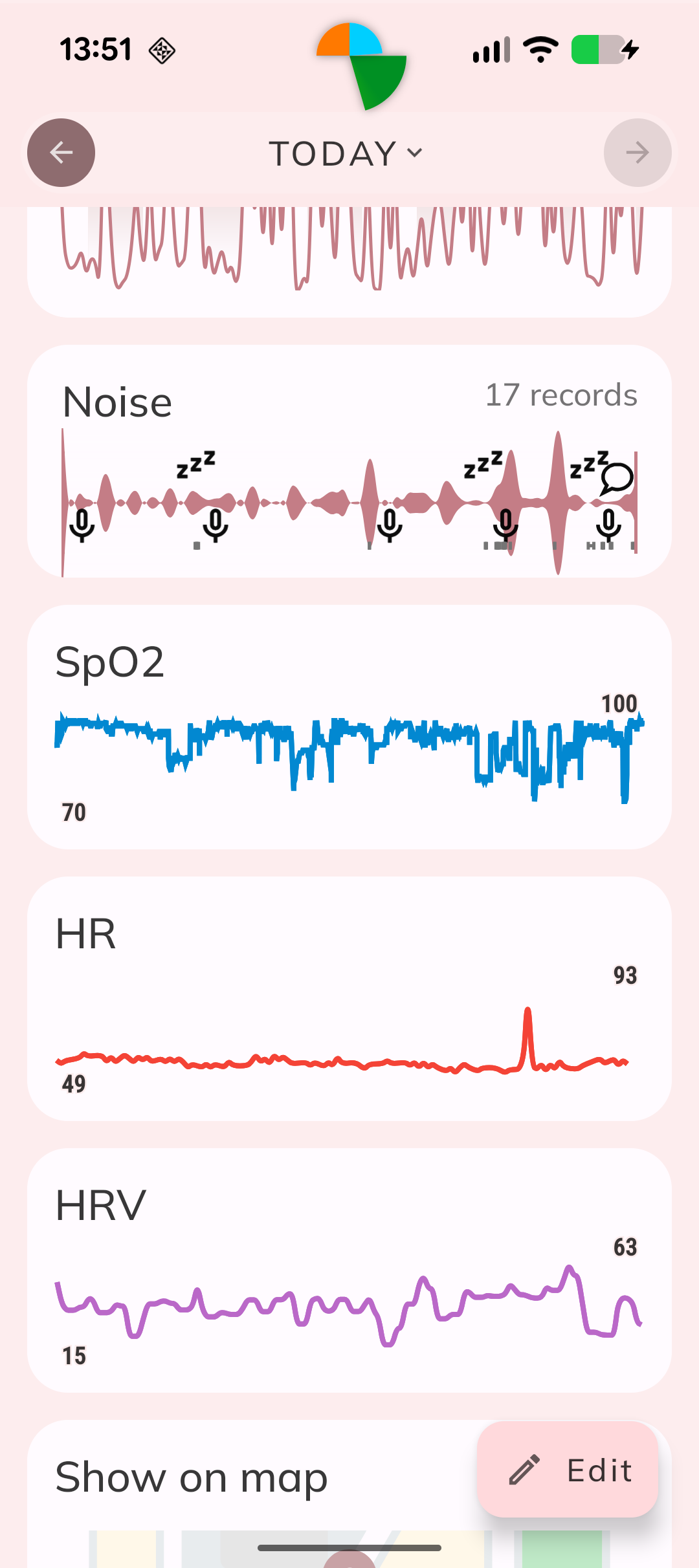I have been working on sleep tracking tech for the last 13 years and since 2010 I have integrated many different wearable devices and platforms with Sleep as Android (our pioneer sleep tracking app).
We integrated nearly every wearable with an open API…
Starting with the king of smartwatches the Pebble and the early Android Wear devices, moving over to Garmin, Samsung’s Tizen-based Gear and then Galaxy devices, FitBit, Xiaomi Mi Bands + Amazfit, and then Zepp devices (via Tools & Mi Band / Amazfit or Notify & Fitness apps), the open source PineTime, some Polar heart rate trackers or BerryMed oximeters and many more…
Over those years I got really frustrated with the Wearable space, especially over its proprietary or non-existent APIs, terrible battery life, restricted access to sensors, and general closeness.
Pebble was perfect…
And it looked so bright in 2013 when the first Pebble came out, nearly a perfect smartwatch with open APIs, the perfect e-ink screen (still missing from most wearables today, apart from Garmin), a fantastic price tag, and most importantly, at least 7 days of battery life, even when doing sleep tracking with Sleep as Android every night. We haven’t seen such a great combination of features, durability and price since 2016 when Pebble, unfortunately, closed down and sold its business to FitBit.

The king is dead, no smartwatch to recommend…
Now that the King has died, people have been asking me what wearable I would recommend, and I have ended up with a canned answer that goes over the list of all the wearables on the market, and I really can’t honestly recommend any of the devices on that list. Until now, when I bought and tested the new Mobvoi TicWatch 5 Pro.

TicWatch 5 is IMHO the new king we have been waiting for the last 7 years…
The game changer for TicWatch 5 is IMHO the new Snapdragon W5+ Gen1 chip combined with Mobvoi’s unique dual display technology. No other Wear OS device on the market can match this.
My daily battery consumption with TW5 is 15% with ~8 hours of Sleep as Android sleep tracking. I collect SPO2 and RR intervals once every second during the entire time of the sleep!
Those missing 15% battery gets charged in the morning in less than 10 minutes.
Get HR, HRV, and SPO2 during the entire sleep…
Mobvoi is to my knowledge the only Wear OS vendor that has decided to open up all the sensors through a standard Android sensor API, making TW5 the first Wear OS device where Sleep as Android can track all the 3 important body sensor metrics: HR, HRV, and SPO2. So in the morning you can see how efficient your sleep was in resting your body through increased HRV and we will check for any respiratory disturbances that may indicate some serious respiratory issues.

Same battery life like Pebble but finally better at features…
To conclude, with TicWatch 5 you get the same battery life as you got with a Pebble 10 years ago, but in a package with a modern operating system that is easy to develop apps for, with new sensors able to find out more about your body and sleep and last but definitely not least — like the first Pebble — you get an always-on time display (thanks to their Ultra-low-power display layer) with no impact on battery. Believe it or not, you can even use your smartwatch, well, like a regular watch telling you what time it is!
No melatonin disrupting blue light for better sleep…
The ability to change the backlight of the Ultra-low-power display may seem like icing on the cake. But not so when you are familiar with the negative effect of blue light on your sleep through its melatonin-suppressing effect. Of course I have mine set to RED! You can even install my app Twilight on your TW5 which will further filter out blue light from all the other screens on your watch (and phone).

All of these features give the Tic Watch 5 a real edge over any other wearable on the market, making it the perfect choice for anyone interested in sleep.
There is no Wear OS like a Wear OS…
Unfortunately, you won’t get the same experience from other Wear OS devices at the moment. They lack the dual-layer display and always-on OLED makes them battery-hungry even with the latest Qualcomm chips.
Also, other Wear OS vendors tend not to open up the sensors and their sensors are not as battery efficient. For instance, on the Galaxy Watch (4,5,6) you need to implement Samsung’s proprietary API the “Privileged Health SDK” and reading SPO2 every second like I do on the TW5 will eat 100% battery in less than ~7 hours (where TW5 only consumes 10%). This is why we are not doing SPO2 or HRV tracking on the Galaxy Watch line.
In case of Pixel Watch 1 and 2, unfortunately Google did not make either SPO2 or RRI sensors available for the 3rd party devs.
It’s not perfect but it’s really close…
Don’t get me wrong here, the TW5 is not perfect, it also has a few CONS. It is Wear OS 3 based, where Google has already released Wear OS 4 and at the moment Google Assistant does not work on the watch.
Still, for me TW5 is the light at the end of the tunnel, it shows that we can have a modern Smartwatch with great battery life without sacrificing features. It also means a lot for the Wear OS platform.
This makes Wear OS the most interesting wearable platform into the future…
Finally, the hardware has caught up with Wear OS! Even Google doesn’t seem to care too much about Wear OS and we have all these bugs, still, TW5 makes Wear OS the most interesting platform into the future to bet on. I believe TW5 is just the start and we will see more such capable devices hopefully even from other vendors soon…

56 thoughts on “We finally have a new king of smart watch!”
Thanks!
I have an Enduro – works.
I have used a TWP5 since they were released. I usually get 2 full days and nights from one charge.
Some things I have done to extend battery:
In the settings, change “always on screen” to “ultra-low-power display” and “tilt to wake” to “AMOLED”. – this will keep the screen on the LCD with low battery drain until you physically move your arm to look at the screen. Then you will get the nice AMOLED. Saves a ton of battery.
You can also schedule “essential mode” under the “system” menu (also in settings). I set mine for ~5 hours when I know I will be asleep. In essential mode some features continue to run in the background, including step counting, sleep tracking, and heart rate tracking but I believe the WiFi radio is off.
If these don’t get you at least 30 hours of power, you might have a bad battery. Reach out to Mobvoi for help.
Thanks for the tips!
Though – wouldn’t backlight (which is the ultra low power display) be the more power saving option for tilt to wake over the AMOLED display?
Yes, it would. I didn’t think it was necessary as I was getting the battery life I was looking for, and still got to enjoy the custom OLED watchface
Gotcha, thanks for the clarification.
Setting the brightness a step lower is something I hadn’t done yet – I was thinking the adaptive brightness would override that anyways.
A little more battery life, one step at a time – yay!
Sean, you’re actually not right. I strongly advise taking it one step further (and I believe it’s the default setting) — set “tilt to wake” to background color instead of AMOLED. This way, the AMOLED screen only turns on when you actively tap the display.
This is the best setting because you move your arm a lot. And I mean a looooooot. I always find it amusing to see people with an Apple Watch—how their display keeps turning on every time they move their arm, even when they don’t intend to check it. With your setting, you’re making the same mistake.
With my setting, you significantly save battery life without any downsides, since you still get plenty of information from the “ultra-low-power display.” AMOLED is really only necessary when you need to interact with the watch or use apps.
The other setting you suggested doesn’t make sense, at least in the context of this site. Your watch needs to stay awake when you sleep so that it remains connected to the app. If you switch to Essential Mode, you lose the connection, and Sleep as Android stops working. I’m sorry, but that’s actually harmful advice.
One more tip—if you experience extremely high battery drain, to the point where your watch barely lasts a day, try restarting it. Sometimes, weird issues can occur that a simple reboot can fix.
Hi, if anyone is interested, there is a 60% sale on TicWatch PRO 5 on the Mobvoi website
https://www.mobvoi.com/ca/products/ticwatchpro5 (It is not an affiliated link, just for your information)
Here are some great smartwatches, Apple, Samsung, Garmin etc. for Sleep Monitoring.
Can anyone please confirm that HR, HRV, and SPO2 still works for TW5 with WearOS 4.0? I recently got it and I only get motion sensing.
Hello, yes it works.. this is my graph from today’s night from TW5..

What settings do I need to configure to see this?
Hello DA, you just need to set Wear OS as your wearable in Settings > Sleep tracking > Wearables, and enable Heart rate monitoring and Pulse Oximetry on Wear OS.. in the same screen.. Did that help?
Unfortunately not. There must be some permissions settings on the phone itself.
Yes, if you start the app on the watch you are asked for the body sensors permission. On latest Android you need in addition to grant this permission all time which requires to do it from the settings. without the body sensors permission the app is not able to read the sensors..
Works now. Hopefully helps Br above too